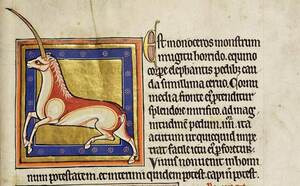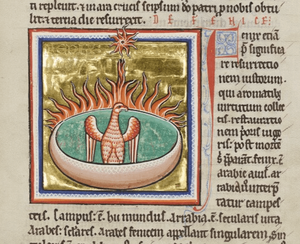From the Medieval Research Blog: "Imagining the Medieval Bestiary"

Medieval bestiaries, which flourished during the twelfth and thirteenth centuries, particularly in England, are compendia of brief descriptions of various animals (sometimes plants and stones are included as well), which offer moral or allegorical lessons, and are often colorfully illustrated.
Basic modern definitions often suggest a sort of binary, ontological taxonomy for the creatures in these texts: bestiaries feature “real” animals (or “actual” or “factual” ones, such as dogs, crocodiles, beavers, and elephants), but also “imaginary” ones (or “mythical,” “legendary,” or “fabulous” ones, etc., such as unicorns, phoenixes, and manticores).

Bestiaries themselves don’t appear to distinguish between “real” and “imaginary” animals, in terms of the arrangement of entries or the way that creatures from these two categories are verbally described or artistically depicted; the distinction is a modern and anachronistic one. Furthermore, bestiaries’ inclusion of hard-to-believe anecdotes about well-known creatures who actually do exist (e.g., the stag’s alleged habit of drowning snakes) renders the boundary between “real” and “imaginary” animals, as we might consider it, less firm in these texts. At stake in the discourse of the “real” versus the “imaginary” in bestiaries is our view of medieval thinkers.
One approach to the “imaginary” animals in bestiaries—a very old approach to interpreting mythical creatures, in fact—is rationalistic: positing that even the legends have some basis in reality, and that real animals were, through a combination of misunderstanding and literary transmission, rendered (almost) unrecognizable. Notable proponents of this view in modern times have included T. H. White (1954), and more recently, zoologists Wilma George and Brunsdon Yapp (1991).
This is an excerpt from "Imagining the Medieval Bestiary" by Dr. Emily Mahan (Ph.D. '22) Read the full story.